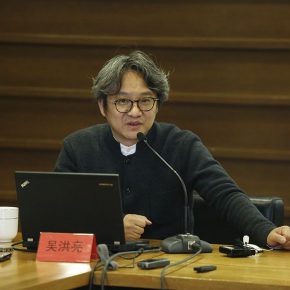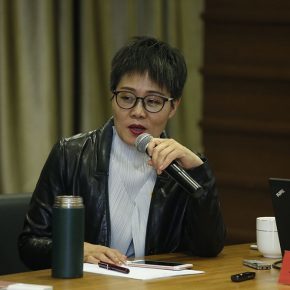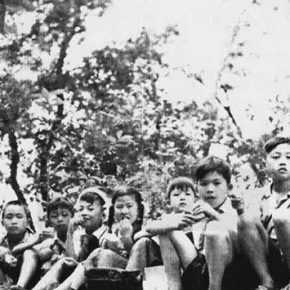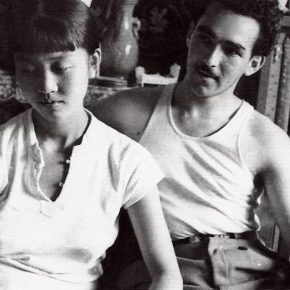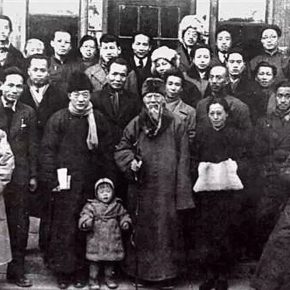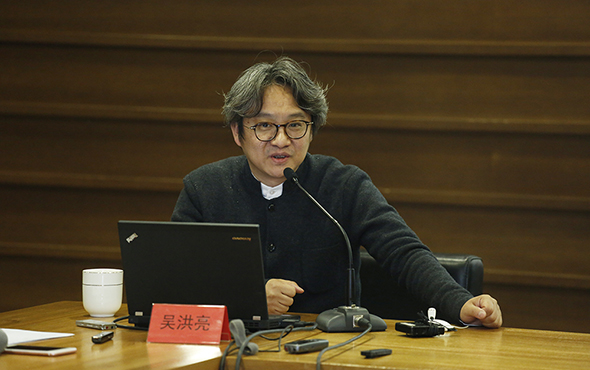
At 6:30 pm on April 4, 2018, Wu Hongliang, Deputy Dean of the Beijing Fine Art Academy and Director of the Art Museum of Beijing Fine Art Academy, presented a lecture entitled?“Xu Beihong and?No. 2A Dayabao Hutong” in the VIP room of the CAFA Art Museum and it was presided over by Associate Professor Guo Hongmei, Director of Theoretical Publishing Department at CAFA Art Museum. It was the fourth round of the series of lectures during the “Celebration of the Centennial of Central Academy of Fine Arts: Xu Beihong–Living Art Forever”.?In the lecture, Wu Hongliang started with the relationship between Xu Beihong and No. 2A Dayabao Hutong, then selected four historical time nodes and?returned to historical events?to review and?analyze changes in people and events, thus restoring historical events and?stories while?outlining the art ecology of the 20th century.
At the beginning of the lecture, based on the relationship between Xu Beihong and No. 2A Dayabao Hutong, Wu Hongliang briefly explained the topic of the lecture. Xu Beihong purchased a staff quarter at No. 2A Dayabao Hutong, when he reorganized National Beiping Art School in 1946. There were dozens of famous artists and?theorists such as Ye Qianyu, Hua Tianyou, Li Kuchan, Li Keran, Dong Xiwen, Li Ruinian, Wang Chaowen, Yan Han, Zhang Ding, and Maryn Varbanov who had lived in this place. In 2016, Wu Hongliang was invited to write a related article for the exhibition of “No. 2A Dayabao Hutong” which was held by Li Keran Art Foundation in Hong Kong, so that Wu Hongliang had visited the site in which the old No. 2A Dayabao Hutong was located. It is gratifying to note that it is still there despite many vicissitudes of life and it has been renamed No. 5 Dayabao Hutong.
In the opinion of Wu Hongliang, many people and events of No. 2A Dayabao Hutong were related to the history of Chinese art from the 20th century, and Xu Beihong, who was the principal of the National Beiping Art School and the first president of the Central Academy of Fine Arts, was inextricably linked with the people living in No. 2A Dayabao Hutong, which had also become an important historical site witnessing the development of Chinese art in the 20th century. The study of No. 2A Dayabao Hutong was another way to evidence an historical timeline and this on-site timeine might encourage people to re-perceive the era and the relationship between art and artists in that era, to explore the deep state hidden in the phenomena.
Wu Hongliang was inspired by this and began to work on some simple research and designed a drama?that spanned the middle and?late 20th century depending on the stories of the time at the No. 2A Dayabao Hutong. It became a stage, where people arrived and moved on from. The stories happening in this place became a picture of the Chinese art ecology in the 20th century. Later, the stories happening in No. 2A Dayabao Hutong were divided into four parts, respectively starting from 1948, 1953, 1956, and 1973, which unveiled “historical scenes”.
Time Node 1: 1948 ?????
In 1948, Dayabao Hutong embraced many residents for the first time. Ye Qianyu and his wife Dai Ailian moved in in 1948, while Dong Xiwen, Hua Tianyou, Li Kuchan, Li Keran, Li Ruinian, and Wei Jiangfan, who had just graduated from school,?all moved in during the same year.?Wu Hongliang found that the artists who stayed in this place were closely associated with Xu Beihong, they were Xu’s like-minded friends, or young people who were always being guided and supported by Xu Beihong. They later became the backbone of Xu Beihong’s promotion of realistic artistic ideas. In 1928 and 1946, Xu Beihong was assigned the post of president of the National Beiping Art School twice and he promoted the realism of Chinese painting and the teaching, which caused many teachers of Chinese painting to resign. Wu Hongliang believed that Xu Beihong reorganized the National Beiping Art School and employed innovative artists who stayed in No. 2A Dayabao Hutong, thus forming a team that supported and?disseminated Xu Beihong’s artistic concepts. It also meant the beginning of the stability of the National Beiping Art School in a new era.
Time Node 2: 1953 ???
On September 26, 1953, Xu Beihong contracted an illness and died. The personnel of Dayabao Hutong began to change during this year and it was an important historical moment. In 1949, the “National Beiping Art School” was merged with the Department of Fine Arts of North China University to establish a new school entitled “National Academy of Fine Arts”, which was renamed the Central Academy of Fine Arts in 1950. Wu Hongliang found that Xu Beihong, who was the first president, had complex thoughts rather than being fully satisfied or content with the influence of the new political environment and literary and art policies. When Wu read the documents. “Art Services for the Workers, Peasants and Soldiers” advocated by New China it led to Dayabao artists’ artistic creations encounter difficulties. In 1950, some people suggested that the flower-and-bird paintings could not serve the proletariat, so that Li Kuchan, who was good at freehand brush work, was unfairly treated. Later, the Ministry of Culture organized a delegation to visit the grottoes in Gansu; the Central Academy of Fine Arts organized a training program for the teachers engaged in Chinese painting, training them to draw models, studying line drawing and so on, reforming the traditional creative ways of Chinese painting. In the year of Xu Beihong’s death, Li Kuchan and Wu Guanzhong moved away from the Dayabao Hutong. Li Ruinian also moved away at the end of 1952 when he was invited to teach in the Department of Fine Arts at Beijing Normal University. While at the same time, some new people moved in. In 1953, Huang Yongyu & Mei Xi and Ding Jingwen & Zheng Xuewen moved into the Hutong. Both Huang Yongyu and Ding Jingwen have made considerable contributions to art education in New China.
Time Node 3: 1956 ?
In 1956, three major transformations were completed and the socialist system was basically established. At the same time, it was also a gratifying year for the literary and?art circles–Chairman Mao put forward the policy of “l(fā)et?a?hundred?schools?of?thought?contend and let?a?hundred?flowers?blossom”. The artists could freely deliver speeches and freely create to a certain extent after a short period. Many people moved away from Dayabao, and a few foreign students moved in, while China slowly settled down and started international exchanges. Because Central Academy of Craft Art was established in that year, Zhu Danian, Liu Weihe, Yuan Mai and Cheng Shangren were transferred to Central Academy of Craft Art and moved away from the Dayabao Hutong. The Bulgarian student Maryn Varbanov and his Beijing wife Song Huaigui moved in that year. Maryn Varbanov was once a visiting professor at the Zhejiang Academy of Fine Arts (now China Academy of Art), and established “Maryn Varbanov?Tapestry Research?Institute”. In the late 1950s, a student from Czechoslovakia and his wife, a woman from Korea, lived in the Hutong. Joseph Hejzlar, a student from the Czech Republic was also associated with the Dayabao Hutong. Joseph Hejzlar studied at the Department of Art History, the Central Academy of Fine Arts and later became an important expert on Qi Baishi in the Czech Republic. Based on these facts, Wu Hongliang said that, Dayabao Hutong had become a platform for the international exchange of art and had brought a different artistic ecology to China, in the closed China of the 1950s.
Time Node 4: 1973
In 1973, Li Keran moved away from Dayabao and Dong Xiwen died in that year. They had both lived in Dayabao for more than 20 years, so they were intimate neighbors apart from being colleagues at the Central Academy of Fine Arts. Wu Hongliang was told of Dong Xiwen’s state in his late years by Dong Xiwen’s daughter Dong Yisha. Wu believed that Dong was severely hurt during the “Cultural Revolution”, and he was mentally tortured due to the “Founding Ceremony”. It was fortunate that Li Keran persisted in the end although he was also tortured.
At the end of the lecture, Wu Hongliang briefly introduced the artists’ children who grew up in Dayabao from 1948 to 1973, including Li Keran’s sons Li Xiaoke and Li Geng, Li Kuchan’s son Li Yan, Huang Yongyu’s son Huang Heiman, and Zhang Ding’s son Zhang Langlang, who are all engaged in artistic creation or art history. Wu Hongliang said that it was because of these people that we had an opportunity to research the Dayabao Hutong. In the end, Wu Hongliang shared with the audience his research methods as a museum curator.
Text by Yang Zhonghui, translated by Chen Peihua and edited by Sue/CAFA ART INFO
Photos of the lecture by Li Biao/CAFA Art Museum
Images of literature?were collected from the network


